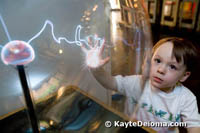story by Kayte Deioma
A visit to American Girl Place was the primary reason for our trip to New York. My nine and seven-year-old nieces, Becca and Sarah had received American Girl dolls and books as gifts. When they learned that there was a place in New York exclusively devoted to American Girl dolls and products, they were dying to go. So their mother and I planned a trip to New York and dragged their 16-year-old brother, Derick, along.
History
If you’re not familiar with the American Girl brand, you probably don’t know any little girls. It started in 1986 as a series of books about eight fictional 9-year-old girls who lived at different important times in America’s history. In addition to creating an interesting way of introducing 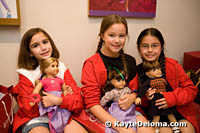 young girls to history, the books focus on issues of friendship, self-esteem and relationships. Each character has an accompanying 18-inch doll and accessories. The original books have expanded into a series about each character.
young girls to history, the books focus on issues of friendship, self-esteem and relationships. Each character has an accompanying 18-inch doll and accessories. The original books have expanded into a series about each character.
Since then, the “Just Like You” series of modern dolls and books was introduced to reflect the diversity of American girls today and the Bitty Baby series was introduced for younger girls. The company also publishes American Girl magazine and operates three American Girl Place stores in New York, Chicago and Los Angeles and American Girl Boutique and Bistro in Atlanta and Dallas.
American Girl Place
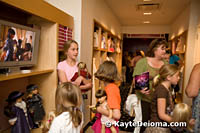 American Girl Place includes a store, historic exhibits, a doll hospital for repairing broken dolls, a doll hair salon, a café and a theatre. It’s possible to spend all day and several thousand dollars there in one visit and I spoke to several people who did just that.
American Girl Place includes a store, historic exhibits, a doll hospital for repairing broken dolls, a doll hair salon, a café and a theatre. It’s possible to spend all day and several thousand dollars there in one visit and I spoke to several people who did just that.
We were on a budget, so the girls were allowed to pick out one outfit for their dolls and got a choice between having tea or dinner at the café or seeing the show. They chose to see Circle of Friends: an American Girls Musical.
For this special occasion the girls decided to dress up and dressed up their dolls as well. Dolls are welcome to participate in all the activities at American Girl Place.
The Store
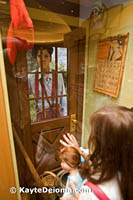 We arrived at the store an hour before the show to have time to shop. We were disappointed in our search for doll clothes, because Becca’s and Sarah’s dolls, bought the year before, were from a limited edition series, the Hopscotch Hill Girls. Since they were a different size than the rest of the dolls, there were no clothes available to fit them. They were somewhat appeased to hear that their dolls were now “real collector’s items.” Becca did end up choosing accessories for the doll’s dog, Licorice.
We arrived at the store an hour before the show to have time to shop. We were disappointed in our search for doll clothes, because Becca’s and Sarah’s dolls, bought the year before, were from a limited edition series, the Hopscotch Hill Girls. Since they were a different size than the rest of the dolls, there were no clothes available to fit them. They were somewhat appeased to hear that their dolls were now “real collector’s items.” Becca did end up choosing accessories for the doll’s dog, Licorice.
The book section has areas where you can sit and read. In the area with the original historic characters, scenes from their stories have been created and life-size video clips create an additional dimension. So there’s plenty to look at even if you’re not buying.
The Doll Beauty Salon
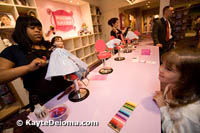 Sarah decided to use her doll clothes budget to have her doll’s hair done in the Doll Beauty Salon. At $10, a dolly hair do is one of the most economical options available. The hairdresser gave the girls lots of tips for successful styling. Sarah was impressed with how much easier it was to work with the doll’s hair when it was wet, and the toothbrush was great for creating perfect bangs. My sister Ellie learned a couple new styles to use on the girls from the video that was playing in the background.
Sarah decided to use her doll clothes budget to have her doll’s hair done in the Doll Beauty Salon. At $10, a dolly hair do is one of the most economical options available. The hairdresser gave the girls lots of tips for successful styling. Sarah was impressed with how much easier it was to work with the doll’s hair when it was wet, and the toothbrush was great for creating perfect bangs. My sister Ellie learned a couple new styles to use on the girls from the video that was playing in the background.
The Show
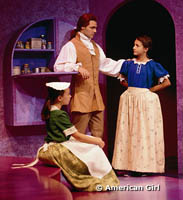 Circle of Friends: An American Girl Musical tells the tale of eight friends in an American Girls club who are planning a surprise birthday party for one of the girls at their club sleepover. As part of the club activities, the girls act out the stories of the historic American Girl characters, Kaya, Felicity, Josefina, Kirsten, Addy, Samantha, Kit and Molly.
Circle of Friends: An American Girl Musical tells the tale of eight friends in an American Girls club who are planning a surprise birthday party for one of the girls at their club sleepover. As part of the club activities, the girls act out the stories of the historic American Girl characters, Kaya, Felicity, Josefina, Kirsten, Addy, Samantha, Kit and Molly.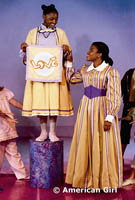 From these stories, they learn lessons they can apply to mending relationships between each other. The friendship lessons hit close to home for some in our group who were going through similar experiences.
From these stories, they learn lessons they can apply to mending relationships between each other. The friendship lessons hit close to home for some in our group who were going through similar experiences.
With it’s proximity to Broadway, it’s no surprise that the show has a top-notch rotating cast of 11 to 13-year-old girls with a few equally talented supporting adults. After the performance, the young actors came out to answer audience questions. Curious minds wanted to know how they each got into acting, as well as how many American Girl dolls they each owned.
Becca and Sarah absolutely loved the show. Ellie and I enjoyed it too. Sixteen-year-old Derick “didn’t hate it.”
The Café
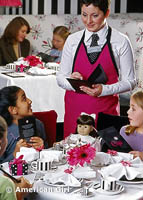 The Café offers a proper, fine dining experience appropriate for girls and their dolls for brunch, lunch, afternoon tea or dinner. There are specific seating times for each and all are fixed-price three-course meals with a variety of main courses from which to choose. Despite our budget considerations, we considered having dinner in addition to the show, but our schedule didn’t leave us enough time beforehand and the Café isn’t open after the second show.
The Café offers a proper, fine dining experience appropriate for girls and their dolls for brunch, lunch, afternoon tea or dinner. There are specific seating times for each and all are fixed-price three-course meals with a variety of main courses from which to choose. Despite our budget considerations, we considered having dinner in addition to the show, but our schedule didn’t leave us enough time beforehand and the Café isn’t open after the second show.
The Bottom Line
American Girl Place is a fun outing for young girls, especially if you have a chance to see the show or have a meal. You can spend a fortune, but you don’t have to. Despite the marketing and merchandizing aspects, the underlying themes behind the American Girl stories can contribute to the development of healthy attitudes in young girls.
American Girl Place
609 Fifth Avenue at 49th Street
New York, NY 10017
1-877-247-5223 (toll free in US)
www.americangirl.com

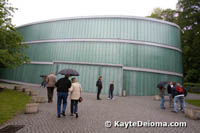 A couple quarrymen found the bones in a cave where they were mining limestone. After the most obvious human remains were removed, the digging continued and the site was buried under tons of gravel, its exact location forgotten. The Neanderthal bones made their way to the Rhine Province Museum in Bonn in 1877, but in 1937 a small Pre-History Museum was opened near the location of the original discovery. It went through various incarnations until a brand new building was opened in 1996 on a nearby site.
A couple quarrymen found the bones in a cave where they were mining limestone. After the most obvious human remains were removed, the digging continued and the site was buried under tons of gravel, its exact location forgotten. The Neanderthal bones made their way to the Rhine Province Museum in Bonn in 1877, but in 1937 a small Pre-History Museum was opened near the location of the original discovery. It went through various incarnations until a brand new building was opened in 1996 on a nearby site.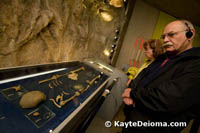 In 1997, archaeologists once again uncovered the original site. In 1997 and 2000 they recovered more bone fragments that matched the 1856 male skeleton, as well as additional remains of a woman and child. These original artifacts, along with replicas of the 1856 discoveries, are on display in the museum.
In 1997, archaeologists once again uncovered the original site. In 1997 and 2000 they recovered more bone fragments that matched the 1856 male skeleton, as well as additional remains of a woman and child. These original artifacts, along with replicas of the 1856 discoveries, are on display in the museum.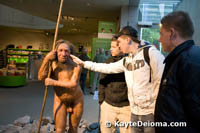 For its 10-year anniversary in 2006, the museum’s permanent exhibit was completely redone, using state-of-the-art technology to create the most accurate depictions yet of what Neanderthal man, woman and child most likely looked like and how they lived.
For its 10-year anniversary in 2006, the museum’s permanent exhibit was completely redone, using state-of-the-art technology to create the most accurate depictions yet of what Neanderthal man, woman and child most likely looked like and how they lived.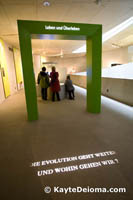 4 million years ago in Africa through today. You proceed from the lower level up a spiraling ramp through time. Themed exhibits includeLiving and Surviving, Tools and Knowledge, Myths and Religion, Nutrition and Environment, and Communication and Society.
4 million years ago in Africa through today. You proceed from the lower level up a spiraling ramp through time. Themed exhibits includeLiving and Surviving, Tools and Knowledge, Myths and Religion, Nutrition and Environment, and Communication and Society.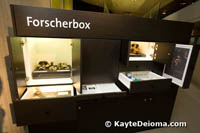 size models of Neanderthal men and women wouldn’t stand out too much in a crowd of modern-day humans.
size models of Neanderthal men and women wouldn’t stand out too much in a crowd of modern-day humans.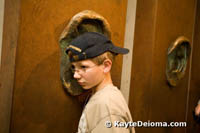 An audio exhibit of giant ears challenges the listener to imagine what cold or a cloud sounds like. To recreate the sensation of being in a grotto, you can stick your head up inside a cave-simulator suspended from the ceiling and look at cave
An audio exhibit of giant ears challenges the listener to imagine what cold or a cloud sounds like. To recreate the sensation of being in a grotto, you can stick your head up inside a cave-simulator suspended from the ceiling and look at cave 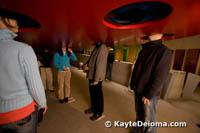 paintings projected on the walls. Kids will be tempted to climb up inside the cave-simulator, but don’t let them. The whole thing is hanging on a few screws and isn’t designed to hold weight.
paintings projected on the walls. Kids will be tempted to climb up inside the cave-simulator, but don’t let them. The whole thing is hanging on a few screws and isn’t designed to hold weight.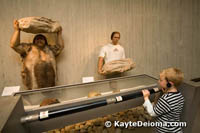 fur-clad ancestor with an Adidas-adorned 21st century German illustrates the relative strength of the two.
fur-clad ancestor with an Adidas-adorned 21st century German illustrates the relative strength of the two.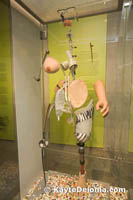 On the upper level is an interesting technology timeline. It shows the progression of technology from a fire flint to a Bic lighter; from a basic bore to a power drill, from a primitive needle and thread to a sewing machine. You can also see the present and future of human evolution with prosthetic limbs and other mechanical replacement parts for the body in use today.
On the upper level is an interesting technology timeline. It shows the progression of technology from a fire flint to a Bic lighter; from a basic bore to a power drill, from a primitive needle and thread to a sewing machine. You can also see the present and future of human evolution with prosthetic limbs and other mechanical replacement parts for the body in use today.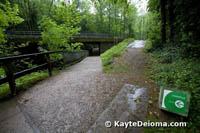 poncho and umbrella, like I did, you can visit the outdoor exhibits. In 2002, three trails were officially added to the museum presentation. The first, marked by green cubes, is theDiscovery Site. It is the shortest trail, just under a quarter mile from the museum. It is the only one on the same side of the street, heading to the right out the front door. The paved trail takes you along the Duessel River to the spot where the bones were found in 1856 and again in 1997 and 2000.
poncho and umbrella, like I did, you can visit the outdoor exhibits. In 2002, three trails were officially added to the museum presentation. The first, marked by green cubes, is theDiscovery Site. It is the shortest trail, just under a quarter mile from the museum. It is the only one on the same side of the street, heading to the right out the front door. The paved trail takes you along the Duessel River to the spot where the bones were found in 1856 and again in 1997 and 2000.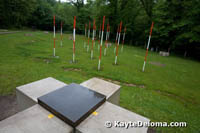 The cave has long since been reduced to quarry dust, and the site on the bank of the river has been replanted with grass and trees, although quarry work continues just over the hill. The Discovery Site (Fundstelle) is marked with red poles and surrounded by concrete crosses with text panels in the middle and plugs for your audio guide. I didn’t realize the audio trail continued outdoors, so I had already turned mine in, but I don’t think I would have wanted to plug in to a wet outlet anyway. The Discovery Site is a limited access area included with museum admission.
The cave has long since been reduced to quarry dust, and the site on the bank of the river has been replanted with grass and trees, although quarry work continues just over the hill. The Discovery Site (Fundstelle) is marked with red poles and surrounded by concrete crosses with text panels in the middle and plugs for your audio guide. I didn’t realize the audio trail continued outdoors, so I had already turned mine in, but I don’t think I would have wanted to plug in to a wet outlet anyway. The Discovery Site is a limited access area included with museum admission.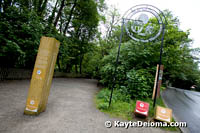 Across the street from the museum, two additional trails are marked out with red and yellow cubes. The yellow cubes mark the Menschenspuren (Human Traces) Trail, which leads to a series of sculptures on prehistoric themes by international artists. At the far end of this loop trail is the Game Reserve, with animals such as brumbies, wisents and aurochs that have been bred to be a close approximation of their ice age counterparts. It is recommended that you allow at least 90 minutes to complete the loop trail. The Human Traces Trail and Game Reserve are open access areas that do not require museum admission and are not restricted to museum hours.
Across the street from the museum, two additional trails are marked out with red and yellow cubes. The yellow cubes mark the Menschenspuren (Human Traces) Trail, which leads to a series of sculptures on prehistoric themes by international artists. At the far end of this loop trail is the Game Reserve, with animals such as brumbies, wisents and aurochs that have been bred to be a close approximation of their ice age counterparts. It is recommended that you allow at least 90 minutes to complete the loop trail. The Human Traces Trail and Game Reserve are open access areas that do not require museum admission and are not restricted to museum hours.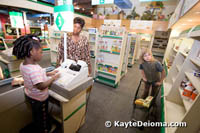 The great thing about exploring children’s museums around the country and around the world is that I get to see how each city puts their own flavor on the play and learn experience. Designed for ages one to eleven, theLouisiana Children’s Museum in New Orleans has some universal favorites like the Kids’ Café where youngsters can cook up pretend food and serve it to their friends or parents. There’s the ever-popular Little Sav-a-Center where kids can shop, run the cash register or stock the shelves. There is also the requisite opportunity to dress up as a fire fighter or police officer and learn about safety issues.
The great thing about exploring children’s museums around the country and around the world is that I get to see how each city puts their own flavor on the play and learn experience. Designed for ages one to eleven, theLouisiana Children’s Museum in New Orleans has some universal favorites like the Kids’ Café where youngsters can cook up pretend food and serve it to their friends or parents. There’s the ever-popular Little Sav-a-Center where kids can shop, run the cash register or stock the shelves. There is also the requisite opportunity to dress up as a fire fighter or police officer and learn about safety issues.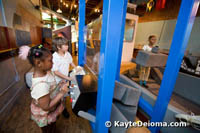 What makes the Louisiana Children’s Museum unique to its home town is the Little Port of New Orleans, where little stevedores can use a gantry crane to load and unload cargo from a barge. Captains can pilot a tow boat down the Mississippi. Ship’s mates can whip up a pretend meal in a cruise ship galley. An interactive wall map lights up to show the different routes that cargo travels to and from the Port of New Orleans.
What makes the Louisiana Children’s Museum unique to its home town is the Little Port of New Orleans, where little stevedores can use a gantry crane to load and unload cargo from a barge. Captains can pilot a tow boat down the Mississippi. Ship’s mates can whip up a pretend meal in a cruise ship galley. An interactive wall map lights up to show the different routes that cargo travels to and from the Port of New Orleans.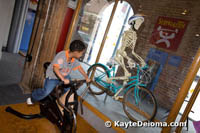 Other exhibits include Body Works, addressing physical fitness and how the body works. You can ride a bike with Mr. Bones, a skeleton that pedals along with you and demonstrates how your bones move when you ride. Measure your height in a magic doorway. Climb a rock wall. Test your balance on the balancing board. Lift 500 pounds with a lever, or lift yourself up with a pulley.
Other exhibits include Body Works, addressing physical fitness and how the body works. You can ride a bike with Mr. Bones, a skeleton that pedals along with you and demonstrates how your bones move when you ride. Measure your height in a magic doorway. Climb a rock wall. Test your balance on the balancing board. Lift 500 pounds with a lever, or lift yourself up with a pulley.